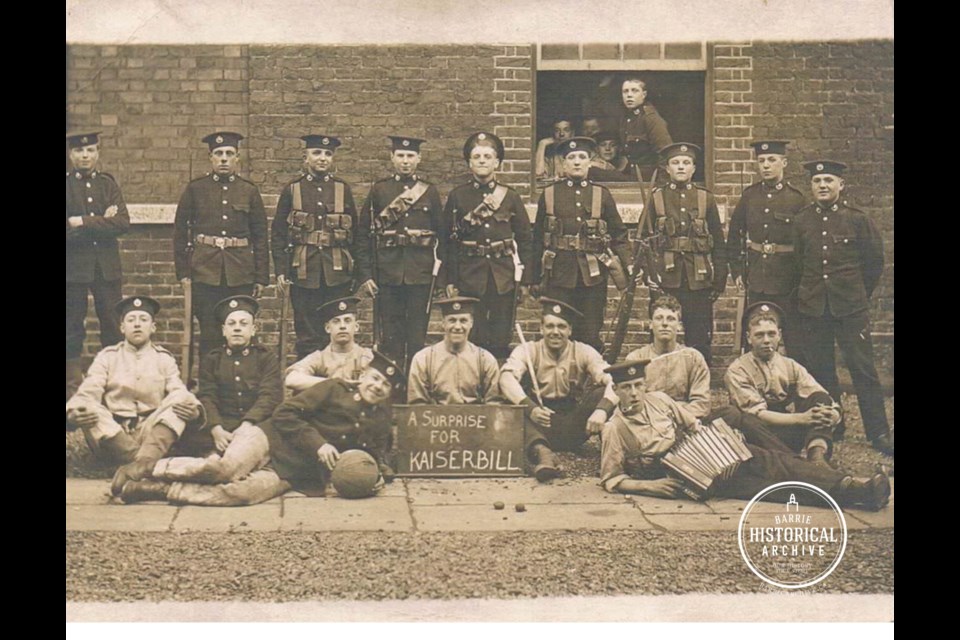To read Part One, click here.
With the exterior of the house surrounded by lawmen, Ed Pye thought better of leaving by way of the cellar window of his mother’s Gowan Street home.
Instead, the accused robber made for the attic but Const. Andrew, now joined by Grand Trunk Railway Const. Atkinson, caught Ed by the legs and dragged him down the stairs. Ed Pye managed to strike one of the officers on the head with his revolver before finally being subdued.
At trial, Ed Pye’s partner in crime pleaded guilty and was sentenced to a year in Central Prison. Ed preferred to go to trial. From his partner’s evidence, the thefts were described and the stolen goods found under a pile of sawdust at Jamieson’s mill, and in a field near the railway lands and also on the person of both accused thieves. It didn’t look good for Ed.
By this time, the Great War had been raging for nearly a year. Ed’s youngest brother, Sylvanus Pye, had enlisted in the forces only a few weeks earlier and, as an unmarried man, his service pay would have been a great support for his widowed mother.
Whether these facts were known to Ed’s lawyer at the time or not, we do not know. Alexander Cowan saw that his client was heading toward conviction and put forward to Police Magistrate Radenhurst a most unusual request. Considering the fact that Ed was unemployed and had a young wife and child, would the magistrate consider a suspended sentence for the offender if he would agree to enlist in the Canadian Expeditionary Force?
Radenhurst took a couple of days to think about it. In the end, he agreed. Perhaps as a show of moral support and solidarity, Ed’s elder brother, Samuel Eli, enlisted along with him. The pair signed up on Sept. 18, 1915 and headed for the Niagara Camp.
Sylvanus Pye had quite the time during his war service. Shot in the left thigh at the Somme in 1916, and shot in both legs at Vimy in 1917, he also struggled with an enlarged thyroid and from headaches related to the Coolidge tube X-ray treatments intended to be a cure. Sylvanus didn’t come home until 1918 and spent months in Toronto General Hospital before returning to Barrie.
Meanwhile, Samuel Eli Pye finished his training and was sent to England the following autumn. As he was being prepared for the battlefields of France, it became apparent that he was unfit for service. Part of his problem was the effects of that same thyroid condition that afflicted his brother, Sylvanus. In fact, their father and several of their siblings had this same seemingly genetic condition.
Samuel Pye returned to Barrie in early 1917.
What did Ed Pye do? He deserted. Twice. Police Magistrate Radenhurst was less than impressed. This quote from the Northern Advance of Dec. 16, 1915 doesn’t begin to show how frustrated the court must have been with Ed Pye by then.
“Since enlisting, he has deserted on two occasions, each time being apprehended. The second offence was sufficient for the military authorities who banished him from the battalion and handed him over to the civil authorities. On Tuesday, he came before the P.M. on the remand and was sentenced to six months at the prison farm.”
Burwash Industrial Farm was a brand-new correctional facility when Ed Pye arrived. Built on an isolated spot next to the Wanapitei River south of Sudbury, Burwash came to be nearly self-sufficient in time. The prisoners spent their time growing vegetables, tending livestock or working in the prison sawmill or bakery. What they produced was consumed by the inmates or sold to people in the community.
So ended Ed Pye’s military career and, after he served out his sentence, he returned to his wife and family once more. Now, Mrs. Pye had an interesting story of her own, one that warrants telling as well. Her tale began in Victorian England where the class system was immoveable and the rights of women were few.
Each week, the Barrie Historical Archive provides BarrieToday readers with a glimpse of the city’s past. This unique column features photos and stories from years gone by and is sure to appeal to the historian in each of us.

